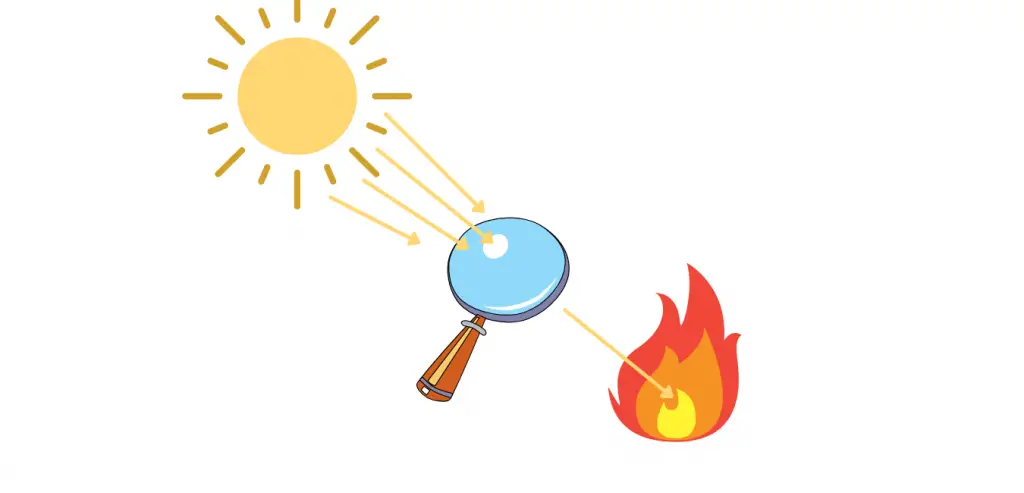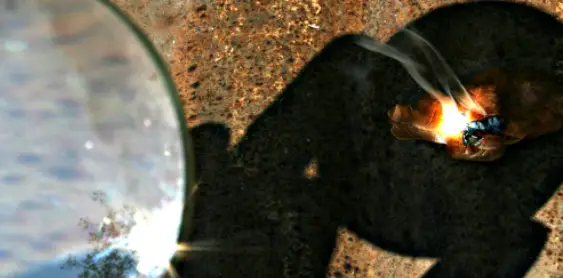
Over two million years ago, humans first discovered fire using wooden sticks and stone tools, but even today, it’s extremely useful to know how to start a fire—instead of using wooden sticks, we have other ways to start a fire. In this guide, we’ll show you how to start a fire using sunlight!
During the stone age, humans discovered fire using sticks and friction, and we can replicate their ways today, but that would take 10-15 minutes to get the fire going. Today, we can use lenses, mirrors, glass, and other easy-to-get materials to start a fire if you’re lost in the woods or camping without a fire-starter.
At Sunvival Guide, we want to give you the best material in the shortest time possible which is why we’ll take you through many ways of getting a fire going, and we’ll even answer some common questions that are frequently asked. Let’s start!
7 WAYS TO START A FIRE USING SUNLIGHT
In this guide, we’re mainly going to be focusing on starting a fire using our sun and other materials that will cause enough heat to build up that our mechanism will erupt in a campfire. Most of these ways will require simple materials, but we are not guaranteeing the success or safety of any of the results.
Lens from Eye Glasses
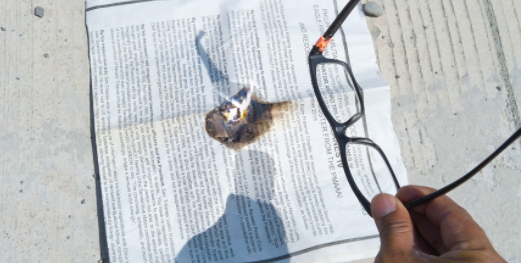
The first step to starting a fire with a lens is to grab some small sticks and dry leaves—this will cause the fire to spread easily. After grabbing the kindles, put them in a group, and grab your lens.
If you hold the lens perpendicular to the sun’s rays towards the kindle, you should see a small, bright dot appear if you’re at the right height and angle—this is focused sunlight. By holding the position for half-of-a-minute, a small fire should start!
This process will NOT work if the sun isn’t out or if you’re using glasses for farsightedness—strong reading glasses will work the best.
Parabolic Mirror
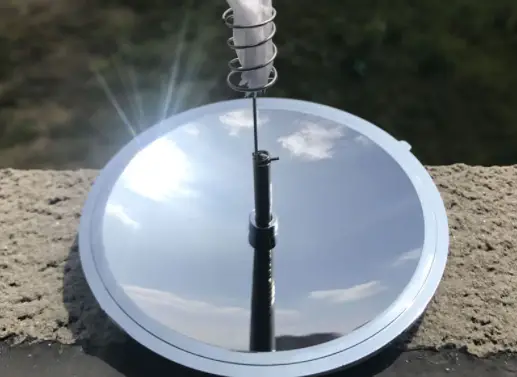
A parabolic mirror looks like a mirror made into the shape of a hemisphere—it’s meant to direct every possible sun-ray into a focal point. The first step is to position the sphere so that the opening is perpendicular to the sun’s rays.
After that, if you grab a piece of paper or anything that’s dry and flammable, it should be held at a certain height either within the hemisphere or slightly above it—after holding it for a few seconds, you’ll see the sun-rays, and you’ll be able to make a fire after half-of-a-minute.
Flat Mirrors
This method is a little harder, but it works in the same way that a parabolic mirror works. First, you’ll need a lot of small, flat mirrors—you’ll have to set up the mirrors, so the angle of the sun comes in, hits the mirror, and lands on your kindle.
You’ll have to repeat this with all of the other mirrors until you have every mirror reflecting the sunlight to a single point, and after waiting a while, you’ll have a fire! One of the downsides to this method is that it’ll take a longer time to start a fire, but the more mirrors you have, the faster it’ll set on fire.
Magnifying Glass
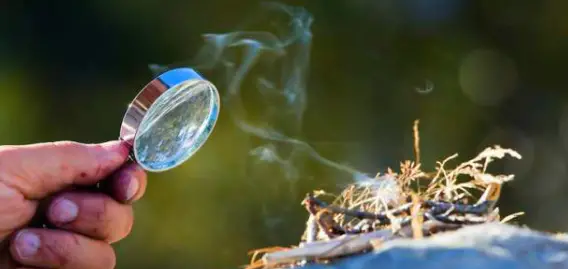
This is the easiest method to use! All you will have to do is hold up a magnifying glass perpendicular to the sun’s rays and have the focused sunlight beam point to the target. After just a few, short seconds, you’ll start burning the material of your target—it’s that easy!
Please, do not try this method on any person or body part, as the focused heat coming through the magnifying glass is very hot and can cause burns.
Water
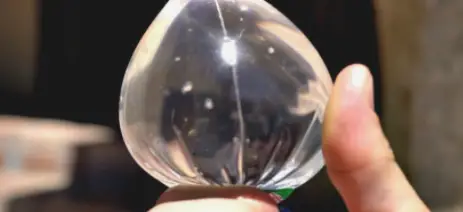
There are plenty of empty water bottles that can be found in nature from people littering. If you were to take one of these water bottles and fill it up with water from a river or a pond, you can use it to start a fire!
You’ll have to treat the water bottle with water inside of it as a magnifying glass and use it to make a focused beam that redirects sunlight onto the intended target.
This method will be a little slower, but it’s still useful if you’re ever lost in the wilderness!
Ice
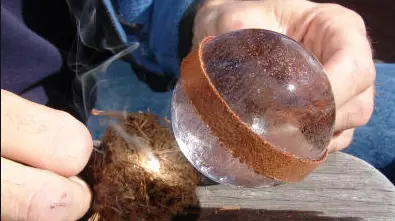
The ice method is a little harder, but if done correctly, it can start a fire quickly. For this, not only does the sun have to be shining, but temperatures have to be below freezing in order for this method to work.
You’ll want to take a medium-sized piece of ice from a pond or a lake, and you’ll want to shave off the ice in order to make the shape of ice look like a biconvex lens- a lens that has both of its side bulging outwards.
Once you have this shape, you’ll want to act quick and use it as a lens from our first method to start a fire! Sometimes, the frozen water can be foggy because of the pollutants in the water, but it should work nonetheless.
Pop Cans
The bottom of a pop can is bulged inwards, making the shape of it appear almost like a parabolic mirror, but a soda can is a lot more “foggier” than a mirror; therefore, some cleanup will be required.
By gathering some dry leaves or rough stones, you can sand off the bottom of a pop can to make the pop can shinier and reflective. When it looks almost like a mirror, you can use our second method, the parabolic mirror, in order to start your fire! It’ll take a little longer, but it will still get the job done.
4 Last Resort Fire Sources
There are four primary ways to get a fire going, but half of them are conventional whereas the other half of the sources are considered to be the “last-resort” ways. The four main ways to start a fire are through:
- Friction
- Sparks
- Chemicals
- Sun
Primary/Conventional
The two primary and most common ways to get a fire started are through using:
- The heat caused by friction
- Sunlight
They’re known as primary methods because of the simplicity and safety that the methods provide.
Friction is the most common method, and the items required for frictional fires can be found in nature. All you’ll need for starters are two sticks—you can further improve the method and speed by using tools such as stone, fabric, or even a hand drill.
Using sunlight to start a fire is another common method due to the simplicity and the speed, but finding the right materials or environmental conditions can be difficult—most of the time, you’ll need a clear day with some form of lenses, mirrors, or glass.
Last Resort
Last resort methods are uncommon ways to start a fire—they simply exist because they do start fires, but most of the time- if done incorrectly- it causes safety hazards or other issues.
Using sparks with stones, rocks, and flint can cause a fire to erupt but it requires more time and better conditions for the fire to start. A battery to steel wool can result in the same outcome, but those two materials are hard to obtain in nature.
Chemicals are the very last resort method since chemicals can be bad to inhale, and/or they can often lead to combustion if used incorrectly. Finding chemicals to start a fire can also be difficult if you only have basic camping gear.
Common FAQS
There are many other methods and ways to start a fire, but we can only cover so many which is why we chose to cover the most common ways—just keep in mind that these are the common ways of using sunlight, but there are more methods out there that don’t involve sunlight.
Let’s answer some frequently asked questions about methods involving sunlight!
How do I focus sunlight into a beam?
Without getting too technical and “scientific”, the simple answer to focusing sunlight into a beam is by using a lens! Eyeglasses work by bending light coming into a point closer or further than your focal point which is great for focusing sunlight as well!
Water and mirrors will do the same effect since they’re reflecting light instead of refracting light which is what lenses do—if you think about it, magnifying glasses and reading glasses are made from almost the same type of lens; it’s just that one lens is bigger than the other.
How Hot Can Focused Sunlight Beam Get?
Focused sunlight can get really hot at times—if done properly on a sunny day, heat from focused sunlight from a magnifying glass can reach up to 1,800° Fahrenheit. This is plenty enough to cause a fire to break out and much more.
For reference, by reaching points of 1,800° Fahrenheit, you can melt aluminum and brass, and you can almost melt copper and gold.—there have been some industrial usages to focusing sunlight to melt materials with giant magnifying glasses to save energy and cost.
What other things can I possibly do by learning how to start a fire with sunlight?
Learning how to start a fire by focusing sunlight is useful for starting campfires without firestarters if you’re lost in the woods one day or if you forgot to bring matches to a camping trip, but there’s another big thing you can achieve- solar cooking!
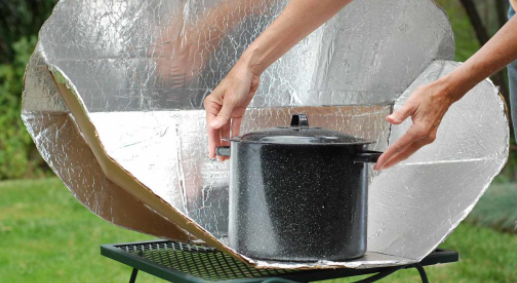
Solar cooking is using sunlight focusing to cook food inside of an oven. Most solar ovens have a sort of glass opening and parabolic mirrors on the bottom to focus sunlight into a glass chamber to cook food using the greenhouse effect.
The temperatures inside of a solar oven can reach up to 300° Fahrenheit which is enough to cook a steak or make cookies! The best part about it is that you don’t need any electricity or complicated components—just a couple of mirrors and the sun is enough to do the trick.
Conclusion
Learning how to start a fire can be very beneficial to anyone, not just to those who camp—it’s a survival skill that was used by our ancestors of two million years ago, and it can save your life today. And even if you aren’t a forgetful person, and you remember to bring your matches or fire starters, accidents can happen. Plus, it’s a cool party trick as well!
Fire starters use the spark method to start a fire, and matches use sparks and combustion to get their fire started, but as technology improves, more abilities are created—they make flammable flares that stay lit underwater!
Hopefully, this simple guide helped you learn how to start a fire, and you can practice and improve your skills starting today—have fun, have patience, and stay safe!

